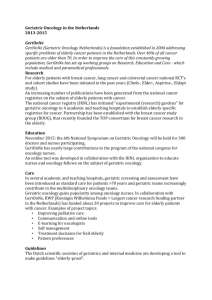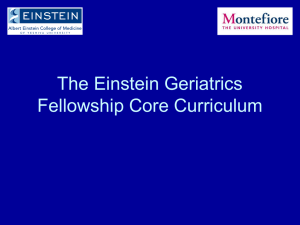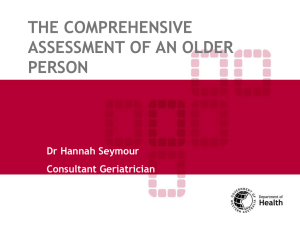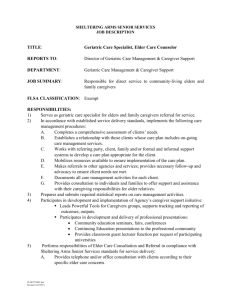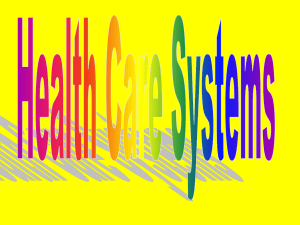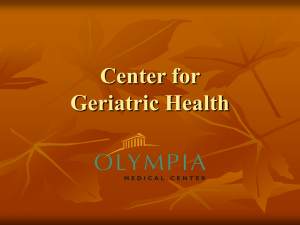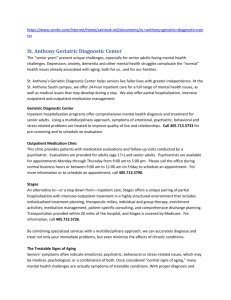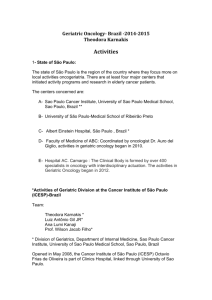The Development of a Geriatric Oncology Program at a Major
advertisement
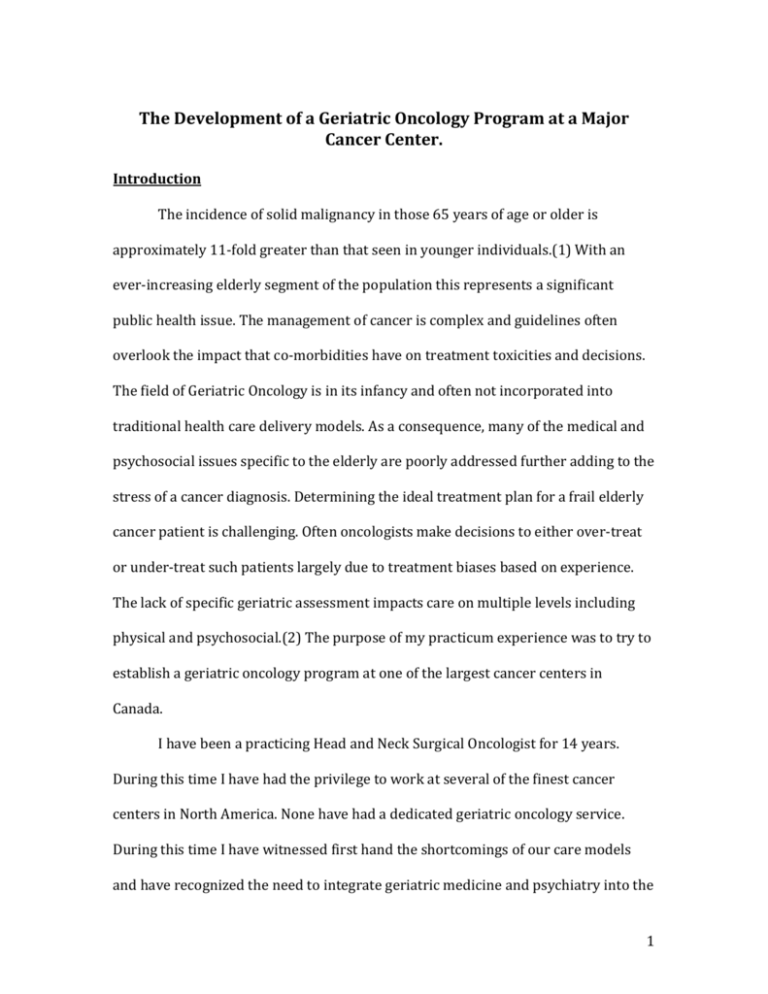
The Development of a Geriatric Oncology Program at a Major Cancer Center. Introduction The incidence of solid malignancy in those 65 years of age or older is approximately 11-fold greater than that seen in younger individuals.(1) With an ever-increasing elderly segment of the population this represents a significant public health issue. The management of cancer is complex and guidelines often overlook the impact that co-morbidities have on treatment toxicities and decisions. The field of Geriatric Oncology is in its infancy and often not incorporated into traditional health care delivery models. As a consequence, many of the medical and psychosocial issues specific to the elderly are poorly addressed further adding to the stress of a cancer diagnosis. Determining the ideal treatment plan for a frail elderly cancer patient is challenging. Often oncologists make decisions to either over-treat or under-treat such patients largely due to treatment biases based on experience. The lack of specific geriatric assessment impacts care on multiple levels including physical and psychosocial.(2) The purpose of my practicum experience was to try to establish a geriatric oncology program at one of the largest cancer centers in Canada. I have been a practicing Head and Neck Surgical Oncologist for 14 years. During this time I have had the privilege to work at several of the finest cancer centers in North America. None have had a dedicated geriatric oncology service. During this time I have witnessed first hand the shortcomings of our care models and have recognized the need to integrate geriatric medicine and psychiatry into the 1 routine care of elderly cancer patients. I often remark to my students that mental illness and advanced age are two of the most important prognosticators for cancer patients because they often result in treatment bias that leads to under-treatment and, sadly, at times no treatment at all. In August of this year I was given the honor of becoming the Chief of Surgical Oncology at my center. This placed me in a position that could affect change and I decided that this would be a focus of mine. The impetus to create a Geriatric Oncology program at my center was the result of one patient’s experience. This 82 year-old man initially presented with an advanced cancer of his maxillary sinus. He had just lost his wife to heart disease and his children were not prepared to lose him too. The patient and family were keen to be aggressive. We decided to offer radical surgery and radiation to this man who appeared to be in reasonably good health. We did not seek a geriatrician’s opinion. The patient initially did well with the surgery but the radiation quickly took its toll. He became wheelchair bound, confused, isolated, and a burden to his children who did not have the ability to provide the level of home care he needed. In desperation I called on my colleagues in Geriatric Medicine for help. They assumed his care and quickly turned his life around. They admitted him into their already established geriatric rehabilitation program, addressed all modifiable co-morbidities, provided assistance to the family, and had the patient attend activities at the day hospital. Within two months he walked into my clinic, no longer appeared confused, and had regained some quality of life. I was made aware that many of the consequences of treatment had been potentially avoidable but needed to be identified and managed at the outset of treatment. 2 I used my practicum as a first step to the implementation of a sustainable Geriatric Oncology Program by designing a pilot study to prove its quality and importance. Methods My goals for the practicum changed during the course of my 15-week experience. Initially my goal was to create a program and immediately start flowing patients through. I imagined that I could bring the necessary services together and convince the center’s senior leadership team that this was a worthwhile investment. This clearly became impossible and I realized that I needed to provide evidence that such a quality initiative would be of value to the system. Together with my supervisor, I decided that I would create a longitudinal study on the impact of geriatric medicine on cancer care at our center with the objective of designing metrics that would assess quality and impact. I identified a funding agency that would potentially see value in such a project. My goal quickly became to put together a multidisciplinary team, create a shared vision of what our Geriatric Oncology Program would look like, and write and submit the grant on time. Results/Outcomes As I mentioned, I initially wanted to jump right in, create the program, and start flowing patients through. I created a document describing how I thought this should be operationalized and presented it to our head of Geriatric Medicine. I was shocked at the resistance I met. It was clear that this approach would never succeed. We both felt that this was an important initiative but we were diametrically apart on 3 the operational and academic vision. Furthermore, senior leadership made it quite obvious to me that funding such a program would not be possible in the current fiscal environment. It became clear that the only way to succeed was to create a pilot program that brought together all of the services involved in the care of the elderly and develop a study design that would highlight the value of such a quality initiative. Furthermore, in order to ensure that this would be sustainable I had to illustrate its value to the medical system using objective metrics of quality. My first challenge was to get all of the stakeholders together and articulate my vision clearly enough to get buy-in. I did this by scheduling meetings with each division head. I tried to identify the interests of each division. I then went back to the drawing table to develop a vision that would be potentially shared by all parties. Our medical center is currently undergoing a reassessment of its priorities. Programs that fall outside the strategic priorities are at risk of loosing support. The cancer program is one of the major priorities identified in the plan. Through multiple discussions I made it clear that one of the best ways a division head could garner support at the institutional level for their non-priority program is to align themselves with a priority program such as Cancer. Fortunately, this approach brought Geriatric Medicine, Psychiatry, Palliative Care Medicine, Medical Oncology, Surgical Oncology, and Radiation Oncology together and the process of designing a program and trial got started. The first step was to determine what the program’s goals would be. It was clear that cancer-related outcomes would overshadow any measurable benefits of a 4 geriatric oncology program if the wrong outcome measures were utilized. It is extremely unlikely that such a program will improve cancer-specific outcomes like 5-year survival or disease-free survival. However, a successful program may significantly influence cancer treatment decisions, decrease treatment-related toxicity, decrease unscheduled follow-up visits, decrease unplanned readmission rates, decrease visits to the emergency department, and improve quality of life. These were the outcomes we decided to focus on. We then started to put the program together. We had to establish inclusion criteria. I performed a literature review to identify potential screening tools we could use to identify frail elderly cancer patients who could potentially benefit from geriatric assessment and support. The group chose the Vulnerable Elders Survey (VES-13) as the best validated tool for our study. This screen can be administered over the telephone and is not onerous. It is a validated self-reported function based system that identifies patients at greatest risk of death or significant functional decline over the proceeding 2 years. Patients who score greater than 3 on the VES13 stand a 4.2 times greater risk of death or significant decline as compared to those with scores less than 3.(3) Once identified, patients would have a comprehensive geriatric assessment in addition to the traditional multidisciplinary oncologic assessment. We would then track the impact of the geriatric consultation on the treatment plan and also longitudinally follow patients during the first six months of their cancer journey. Patients enrolled in the program would continue to receive geriatric medical support as needed and, when necessary, psychiatric and palliative 5 care medicine assessments. In addition, program patients in need of rehabilitation would be offered admission to the Geriatric Day Hospital. Quality measures are far more challenging than traditional outcome metrics. The study of quality is quite complex. Some of my time was spent researching how quality is measured, statistically analyzed, and reported. We decided that for the purpose of this pilot we would need a control group for comparison. Historical cohorts were not a possibility because it would be impossible to accurately determine VES-13 scores from a medical record review. In order to allow for a matched analysis we elected to accrue a control group during the first 6 months of study. Patients would be screened and those with VES-13 scores of 3 or less would be followed for 6 months and outcomes would be recorded. However, these patients would receive our current standard of care and would not be assessed by Geriatrics. They would be later used in the statistical analysis to determine whether our geriatric oncology program positively impacted the cancer journey. In addition to the objective measures I already mentioned we wanted to assess the impact that such a program would have on quality of life. We reviewed several validated quality of life questionnaires and decided to use the Edmonton Symptom Assessment System (ESAS), EORTCQLQ-c30, PHQ-2, GAD-7, and SDI-21. (4-7) These instruments will be administered at the time of the initial consultation, at 3 months, and 6 months post-treatment. Comparisons will then be made between groups. 6 Finally I identified a funding agency that would potentially fund such a pilot project. I wrote the grant and submitted it on November 25th. A copy of the grant has been included in my report. While all of the planning was going on we started to operationalize the program. I have submitted an application to our Institutional Review Board for ethical approval of the study. I identified a nurse leader who would assume a leadership role during the pilot. We chose the Head and Neck Oncology Program as our test site for the pilot and identified clinic space for Geriatric Medicine. I hired a research assistant who will be recording all of our data and administering all of the questionnaires. We managed to identify some funding that could be used until we find out if the grant will be funded. We started to flow a few test patients through the protocol in order to identify any unforeseen problems. To date the protocol has functioned quite well. There have been many valuable personal experiences during this process. Perhaps the one that was most challenging and satisfying was the need to inspire and create a shared vision. This called on my leadership skills and drew from some of my teachings from the Masters of Public Health Program. I have always enjoyed leadership opportunities. This experience was unique because I had to articulate a completely new vision and convince a program to rethink its approach to healthcare delivery and reassess its perceived quality. I was fortunate as Chief of Surgical Oncology to be in a position that allowed me to move this agenda forward. Lessons Learned 7 There were plenty of opportunities for self-directed learning during this semester. I was most surprised by how engaged my colleagues were to this idea and how committed they were to improving quality care. It is very easy for all of us to get caught up in the challenges and requirements of our own silos of work. This was truly a multidisciplinary effort that brought together clinicians from a broad spectrum of the healthcare system. It forced all of us to consider how our activities influence the system and challenged us to take a high-level systems approach in order to create a sustainable program design. This is one of the many reasons I believe we will be successful. As opposed to traditional clinical trial design and outcomes research, I found quality research a challenge. The metrics are very different and harder to measure. My self-directed learning in quality research was a great experience and something I found to be of tremendous value. As a health administrator, quality is an extremely important metric and I now feel better prepared to intelligently approach it. This experience has reinforced principles of epidemiologic study from my course material and has forced me to broaden my scope. This project was my first quality initiative and it taught me a great deal about the complexity of healthcare delivery. I was forced to think from a systems perspective rather than my traditional clinician’s focused perspective. I now appreciate the layered complexity of our Cancer Center’s care team and its responsibilities to our patients and community. The interrelatedness of all of the clinical services, that at first glance seems so unrelated, forced me to create an inclusive program. It required engagement of physicians in Geriatric Medicine, 8 Psychiatry, Palliative Care, Oncology, Surgery, Anesthesiology, and Internal Medicine as well as support staff including Nursing, Speech-Language Pathology, Social Work, Nutritional Services, and Physical Therapy. The final vision was so much more detailed and complex because it recognized the need to address the impact of such a program on all of these services. When I reflect on my original plan I am embarrassed by its naïve simplicity. I now understand why my colleague in Geriatric Medicine was initially so opposed. Finally, the greatest part of this experience has been the opportunity to implement something that I feel is essential and a key part of my vision for cancer care. Patient-focused care and personalized cancer medicine are buzzwords being used by hospital leaders. All too often these ideas lack substance and are used to appeal to the sensitivities and wallets of philanthropists. This initiative, although small at the present time, is an opportunity to really focus on the needs of the patient. There is ample evidence that identifies the specific challenges and needs frail elderly patients have and yet we do very little to address them. I want our center to take the lead in Ontario and demonstrate that with a relatively small investment we can simplify the cancer journey for frail patients and, if nothing else, improve their quality of life. There is no question that this program will make life better for at-risk elderly because it offers support that currently does not exist. However, by decreasing the need for expensive in-patient support I am hopeful that additional study will prove it cost-effective as well. This practicum was a wonderful experience and formalized much of what I have been studying. I was able to put so much of my class work into action. This 9 included leadership in public health, biostatistics, social justice and healthcare disparities, program development, and ethics in public health. I am very happy that I waited until the end of my Masters degree to take this course. Providing sufficient time to carry this out in the midst of my busy clinical and administrative schedule did require time management skills as well. References 1. Yancik R. Cancer burden in the aged: an epidemiologic and demographic overview. Cancer 1997;80:1273–83. 2. Extermann M, Aapro M, Bernabei R et al. Use of comprehensive geriatric assessment in older cancer patients: recommendations from the task force on CGA of the International Society of Geriatric Oncology (SIOG). Crit Rev Oncol Hematol 2005;55:241–252. 3. Min LC, Elliott MN, Wenger NS, Saliba D. Higher vulnerable elders survey scores predict death and functional decline in vulnerable older people. J Am Geriatr Soc. 2006 Mar;54(3):507-11. 4. Watanabe SM, Nekolaichuk CL, Beaumont C. The Edmonton Symptom Assessment System, a proposed tool for distress screening in cancer patients: development and refinement. Psychooncology. 2012 Sep;21(9):977-85. doi: 10.1002/pon.1996. Epub 2011 Jun 13. 5. Kroenke K, Spitzer RL, Williams JB, Löwe B. The Patient Health Questionnaire Somatic, Anxiety, and Depressive Symptom Scales: a systematic review. Gen Hos Psychiatry. 2010 JulAug;32(4):345-59. 6. Wright EP, Kiely M, Johnston C, Smith AB, Cull A, Selby PJ. Development and evaluation of an instrument to assess social difficulties in routine oncology practice. Qual Life Res. 2005 Mar;14(2) :373-86. 7. Luckett T, King MT, Butow PN, Oguchi M, Rankin N, Price MA, Hackl NA, Heading G. Choosing between the EORTC QLQ-C30 and FACT-G for measuring health-related quality of life in cancer clinical research: issues, evidence and recommendations. Ann Oncol. 2011 Oct;22(10):2179-90. 10
